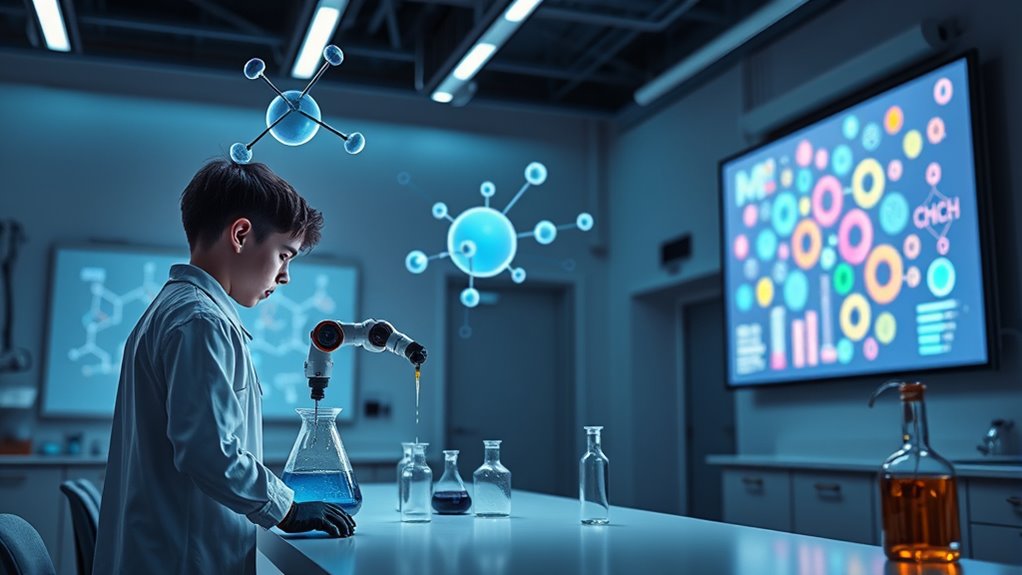AI in the chemistry classroom can be a helpful friend by personalizing lessons and boosting engagement, but it also poses risks like plagiarism and dependency. While AI offers real-time feedback and visual tools that make complex topics easier, relying too much may weaken your problem-solving skills and hands-on experience. Striking the right balance is key. Keep exploring to discover how responsibly integrating AI can truly enhance your learning journey.
Key Takeaways
- AI personalizes learning, enhancing engagement and understanding of complex chemistry topics.
- Ethical concerns, such as plagiarism and dependency, challenge the responsible use of AI in education.
- Over-reliance on AI may hinder hands-on practice and critical thinking skills essential for chemistry.
- Combining AI with visual aids, labs, and peer discussions fosters comprehensive skill development.
- Proper, ethical use of AI can make chemistry more accessible, supportive, and a valuable educational tool.

Artificial Intelligence is transforming the chemistry classroom by offering personalized learning experiences and real-time feedback. As a student, you might find that AI-powered tools adapt to your pace, helping you grasp complex concepts more effectively. These systems can identify your strengths and weaknesses, tailoring lessons to address specific areas where you need improvement.
AI personalizes chemistry learning by adapting to students’ pace and identifying strengths and weaknesses.
This personalization not only keeps you engaged but also accelerates your learning process. However, with these advancements come concerns about how AI impacts academic integrity. Plagiarism concerns are heightened because AI tools can generate answers, summaries, or even entire essays, making it tempting to cut corners. You need to be cautious and use AI ethically, ensuring that your work remains genuine and reflects your understanding.
Many educators worry that reliance on AI might encourage lazy shortcuts rather than genuine skill development. If you’re not careful, you could end up depending too much on AI to do the thinking for you, which hampers your ability to develop critical scientific skills. To truly benefit from AI, you should view it as a supplement, not a substitute, for your own effort.
Use AI to clarify concepts, verify your understanding, or explore new ideas, but always put in the effort to solve problems independently. This approach helps you sharpen essential skills like analytical thinking, problem-solving, and scientific reasoning, which are fundamental in chemistry and beyond. Incorporating high-quality visual aids like projectors can also enhance comprehension of complex topics in science education.
Moreover, AI can be a double-edged sword when it comes to skill development. While it offers immediate feedback on assignments and experiments, it might also lead you to overlook the importance of hands-on practice and deep understanding. Recognizing the importance of visual learning tools can help reinforce theoretical knowledge and promote better retention.
For example, relying solely on AI-generated explanations might prevent you from fully internalizing fundamental principles. To avoid this, balance AI assistance with traditional learning methods, such as laboratory work and peer discussions. This ensures you develop a well-rounded skill set that combines theoretical knowledge with practical application.
Ultimately, AI is a powerful tool in the chemistry classroom, but it requires responsible use. You should be mindful of the ethical implications, particularly concerning plagiarism concerns, and stay committed to genuine skill development. When used correctly, AI can enhance your learning experience, making complex chemistry topics more accessible and helping you become a more confident, proficient scientist.
Frequently Asked Questions
How Does AI Impact Student’S Critical Thinking Skills?
AI impacts your critical thinking skills by transforming how you engage with chemistry. Automated assessments challenge you to analyze data more deeply, while personalized learning adapts lessons to your needs, encouraging problem-solving.
Instead of passively memorizing, you actively think through concepts, fostering independence. This technology pushes you to develop analytical skills, but it’s important to balance AI use so you don’t become overly reliant and maintain strong critical thinking abilities.
What Are the Ethical Considerations of Using AI in Chemistry Education?
Sure, using AI in chemistry education sounds perfect—until you realize privacy concerns might rival your lab safety rules. You might also overlook bias mitigation, risking unfair treatment or skewed results.
Ethically, you need to balance innovation with responsibility, ensuring data stays private and algorithms remain fair. Ironically, what’s meant to enhance learning could undermine trust if these ethical issues aren’t addressed, making AI both a tool and a challenge.
How Accessible Is AI Technology for All Educational Institutions?
You might find that AI technology isn’t equally accessible for all educational institutions. Cost barriers often prevent some schools from adopting advanced tools.
Technological disparities mean not everyone has the necessary infrastructure. Smaller or underfunded schools may struggle to implement AI effectively, making it harder for all students to benefit from its potential.
Overcoming these challenges requires addressing funding gaps and ensuring equitable access to technology.
Can AI Effectively Replace Traditional Chemistry Lab Experiences?
Think of AI as a double-edged sword in chemistry education—you can’t fully replace hands-on experiments, but virtual lab simulations come close.
AI-powered assessments provide instant feedback, enhancing understanding. While these tools boost learning, they lack the tactile experience and real-world skills gained from traditional labs.
How Do Teachers Adapt to Integrating AI Tools Into Their Curriculum?
You should focus on curriculum redesign to seamlessly integrate AI tools into your lessons, ensuring they complement hands-on experiments. Invest in extensive teacher training so you’re confident using these technologies effectively.
Conclusion
Embracing AI in the chemistry classroom is like wielding a superpower—amazing yet requires responsibility. It can transform your learning experience, making complex concepts feel like child’s play. But remember, AI isn’t a magic wand; it’s a tool that needs your critical eye. When used wisely, AI can elevate your understanding to heights you never thought possible. So, don’t fear it—partner with it, and watch your chemistry skills skyrocket beyond the stars!









